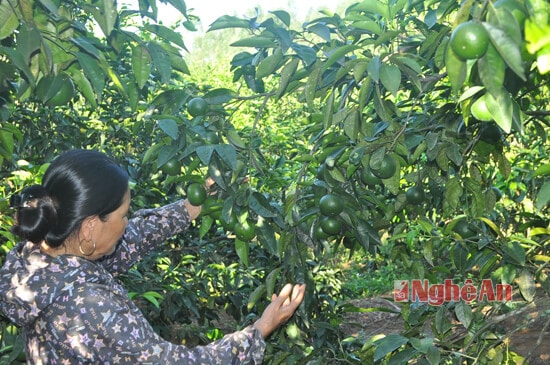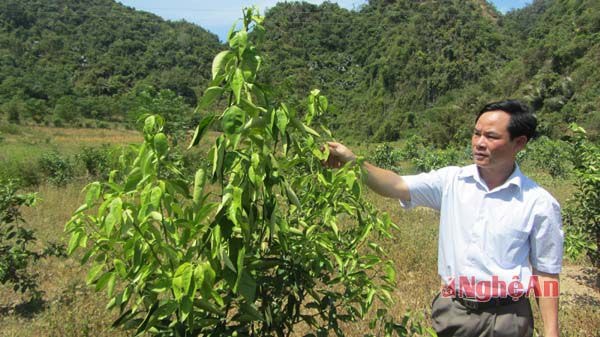Experience in preventing citrus greening disease
(Baonghean) - Greening disease is caused by the bacteria Liberobacter asiaticum living in the phloem of plants, transmitted by the citrus psyllid (Diaphorina citri) as an intermediate host.disease transmission, in addition, the disease is also spread through grafted eyes. The disease blocks the process of transporting nutrients, causing damage to the growth and development of the plant.
In recent years, the development of citrus greening disease has reduced the productivity and quality of citrus trees throughout the province. Therefore, it affects the psychology of gardeners in the process of intensive citrus fruit production. To effectively prevent citrus greening disease, we would like to share some experiences for farmers to apply such as:
It is important to distinguish between yellow leaf disease caused by zinc deficiency and bacterial green leaf disease: bacterial green leaf disease has yellow leaf flesh, green veins, on a tree there are heavy branches, light branches and disease-free branches. The disease progresses relatively quickly so the tree dies very quickly from heavily affected branches to light branches. On the fruit, especiallytangerinesThe first symptom is that the fruit has a red halo from the bottom of the fruit to about half of the fruit, then it falls off. When cut open, the center will be tilted to one side and the seeds will rot. Yellow leaf disease caused by zinc deficiency causes the leaves and veins to turn yellow, appearing simultaneously on all trees or in one direction or a certain plot in the garden. The symptoms are similar, no branch is severely or lightly affected. The progression is very slow, it can last for many years before the tree dies depending on the care conditions.
To prevent yellow leaf and green vein disease on citrus trees (grapefruit, orange, lemon, tangerine, etc.), farmers need to use a combination of many synchronous measures to be effective.
+ Do not use floating seedlings of unknown origin;
 |
Highly effective tangerine and citrus tree model of Mrs. Ho Thi Thanh in hamlet 4, Nghia Tien commune (Nghia Dan) |
- Select breed
+ The seedlings selected for planting must be disease-free plants produced through micro-grafting of growing tips, propagated in a two-door greenhouse and certified. However, these are only disease-free plants, not disease-resistant plants, so we must implement the following other measures to be effective.
+ Do not plant disease-free plants in unisolated epidemic areas;
- Mechanical and farming measures:
+ Regularly visit the garden to detect disease damage early;
+ Cut down diseased trees to eliminate pathogens in the garden. Spray insecticide before removing trees with disease symptoms and infected trees after inspection, destroy to eliminate the source of disease spreading to healthy trees;
+ For strong rootstocks, many new shoots can grow, so it is necessary to prune the new shoots, leaving only 2 - 3 buds;
+ Disinfect pruning tools before moving from one tree to another to avoid contamination.
+ Pruning and fertilizing help control the growth of new shoots 3-4 times a year to manage the appearance of planthoppers in the garden;
+ Plant windbreak trees around the garden to limit the re-infestation of citrus planthoppers from other places;
+ Do not plant attractive citrus trees such as bay laurel, marigold, and kumquat near citrus gardens, especially nurseries producing seedlings;
+ Intercropping: Guava should be planted in the orange garden, 6 months before the orange tree to repel the brown planthoppers as soon as the orange tree is planted.
+ Balanced fertilization increases plant resistance and disease resistance.
 |
| New orange plantations in Yen Khe were also affected by the heat, causing the tops to wilt and the leaves to turn yellow. |
- Biological measures
+ Protect and develop natural enemies of the psyllid: parasitic wasps (Tamarixia radiata and Diaphorencyrtus aligarhensis), weaver ants, and ladybugs need to be protected. When the density of natural enemies in the garden is high, it will reduce the density of psyllid. Use chemical pesticides in rotation and spray properly to protect natural enemies. If possible, raise and release natural enemies in the garden;
+ Planting "trap" plants: The most favorite host of citrus planthoppers is the bay tree (Murraya paniculata), so you can plant this tree in the corners of the garden to make traps to attract planthoppers and use sprays on the plants to prevent and control planthoppers.
- Chemical measures
- Control of disease vectors (psyllids): psyllids are insects that transmit yellow leaf greening disease.
- Prevent planthoppers with chemicals, prevent the ability of planthoppers to transmit diseases. Use some chemicals such as Trebon 0.15 - 0.2%, Sherpa 0.1 - 0.2%, Sherzol 0.1 - 0.2%, Bassa, confidor... spray 500 - 600 liters of mixed chemical solution/ha. Spray periodically to protect the plants with new leaves, especially in spring or the beginning of the rainy season, because planthoppers always choose young shoots to lay eggs.
- For trees showing signs of disease, inject antibiotics to kill the bacteria that cause Greening disease as follows: Use Tetracycline antibiotics, inject pressure into the trunk (the trunk diameter must be at least 10 cm above the ground, 20 - 25 cm). Concentration used: 1 - 2g/liter of water. Dosage: 0.5 liters/injection. Inject antibiotics into the tree trunk 3 times, each time 7 - 10 days apart. After 4 - 8 months of injection, the rate of recovery shoots can reach 90%.
Tran Thi Hoai Phuong
(Nghe An Science and Technology Center)
| RELATED NEWS |
|---|

